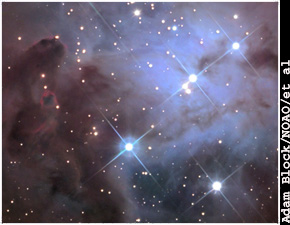Sky
Calendar
January 2006
All
times ET unless noted
By Larry Sessions
Sky Calendar
For January 2006
All times EST
Friday, 12/30
New Moon, 10:12 p.m.
New Moons can't be seen, but look for a crescent
Moon after sunset on Sunday.
Sunday, 1/1
Moon / Venus, 5:00 a.m.
The Moon passes about 7°18' (roughly 14 full moon
diameters) to the South (left) of Venus, this is very hard to see. About a half hour after sunset, the two are only 10-15
degrees above the southwest horizon. The very thin crescent Moon is a challenge.
Sunday, 1/1
Moon at Perigee, 6:00 p.m.
Perigee is the closest point to Earth (361,750
km or 224781 miles this time) in any given orbit. Since this comes near the time of New Moon (12/30 at 10:12 p.m. EST), when
the Sun and Moon are aligned, there may be higher than usual tides (perigean tides). (The next perigee. on 1/30, is slightly
closer.) This also comes at near the same time as Earth's perihelion (1/4), perhaps giving a very slight enhancement to the
Sun's gravitational effect on the tides.
Tuesday, 1/3
Quadrantid Meteors, 1:00 p.m.
Unfortunately the peak comes during daylight,
but the radiant (roughly between Hercules and Ursa Major) is high in the northeast sky several hours before sunrise.
Wednesday 1/4
Perihelion, 10:00 a.m.
Earth's orbit is not a perfect circle, but an
ellipse that brings us sometimes closer, sometimes farther away from the Sun. Surprisingly to many, the closest point, called
the perihelion, comes in early January. This year it is at noon Eastern today, when the Earth is 147,103,600 km or 91,405,939
miles from the solar furnace. This may seem counterintuitive since for us in the Northern Hemisphere it is colder when in
fact we are closer to the Sun. What this shows, however, is that Earth's seasons are not due to changing distances to the
Sun. The seasons are due to the varying tilt of Earth toward (summer) or away from (winter) the Sun.
Friday, 1/6
First Quarter, 1:56 p.m.
The First Quarter Moon rises at around noon, so
look for it in the early afternoon eastern sky. By sunset, it is high in the southern heavens.
Sunday, 1/8
Moon / Mars, 2:50 p.m.
The two are separated by 1°21', but unfortunately
this occurs in daylight. However the two are still fairly close in the Western heavens at night fall. Mars is below (South
of) the Moon.
Monday 1/9
Moon Pleiades, 9:00 p.m.
Moon passes the southern edge of the Pleiades.
The Moon of course drowns out many of the faint stars, but it is an interesting view. If you miss this event, don't worry
as similar passes happen several times this year. On April Fool's day the Moon is a thin evening Crescent, and on July 20
it is a few days before New Moon in the morning sky.
Friday, 1/13
Venus at Inferior conjunction, 6:52 p.m.
Inferior conjunction basically
means that the planet passes between the Earth and Sun. It cannot be seen, but this marks the transition of Venus from the
evening sky to the morning sky.
Saturday, 1/14
Full Moon, 4:48 a.m.
According to Kim Long's "The Moon Book" (Johnson
Books, Boulder),t eh first Full Moon after the winter solstice was known as the "Frost in the Tipi Moon" by the Lakota, the
"Wolf Moon" by the Algonquin, and the "Great Spirit Moon" by the Ojibway Peoples of North America.
Sunday, 1/15
Moon / Saturn, 8:10 a.m.
At this time the two are separated by 3°47'.
Unfortunately, this happens after sunrise in many locations. However, the two are separated by about 7-8 degrees, low in the
East-Northeast, a few hours after sunset. Saturn is to the upper right of the Moon.
Saturday, 1/21
Moon / Spica, 5:00 p.m.
As in December, the Moon passes very near (just
over a half degree) and from parts of Asia actually occults (eclipses) Spica. Unfortunately, this occurs in daytime for North
America, but they are fairly close before dawn on Saturday.
Sunday, 1/22
Last Quarter, 10:13 a.m.
Look in the southern or southwest sky after dawn.
Last Quarter Moons rise at roughly midnight and set at roughly noon.
Wednesday, 1/25
Moon / Antares, 7:00 a.m.
The Moon passes just a couple of minutes
of arc from Antares, but this is after sunrise in many locations. Try observing before dawn. From parts of South America the
Moon occults (eclipses) this bright star.
Thursday, 1/26
Mercury at Superior conjunction, 4:46 p.m.
Superior conjunction is when
Mercury (or Venus) are aligned with the Sun, but on the far side of the Sun from Earth. Due to the Sun's glare, this event
cannot be seen, but it marks the time at which the planet moves from the morning sky to the evening sky.
Friday, 1/27
Saturn at opposition, 5:41 p.m.
Opposition means that the planet is opposite
the Sun in the sky, rising at sunset and setting at sunrise, much like the Full Moon.
Sunday, 1/29
New Moon, 9:14 a.m.
No Moon can be seen, but try after sunset on Monday
and Tuesday.
Monday, 1/30
Moon at Perigee, 3:00 a.m.
Perigee, or closest point to Earth, this time
is 357,778 km or 222,312 miles. Since this comes so close to New Moon, there will be higher than usual tides (perigean tides).
See 1/1.
Tuesday, 1/31
Saturn passes Beehive
Although it has been close for some time (and since
Saturn is the slowest moving naked-eye planet, remains close for some time to come), the Ringed planet is just about a half
degree from the Beehive star cluster in Cancer tonight.
Sunday, 2/5
First Quarter, 1:28 a.m.
As with all First Quarter Moons, this one rises
at roughly noon, is well-placed in the South at sunset, and sets at roughly midnight.
[Note: data for this calendar has been derived from a number of sources including the Observer’s
Handbook 2005 of the Royal Astronomical Society of Canada, Starry Night software, and others.]

